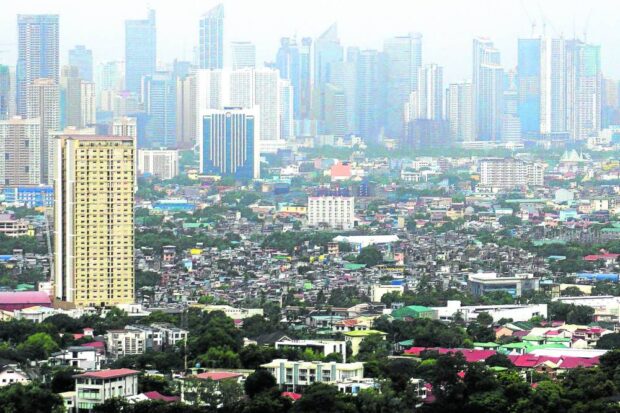
Residential (L) and informal settlers (R) areas are pictured against the backdrop of Manila’s financial district of Makati. (Photo by TED ALJIBE / AFP)
MANILA, Philippines — Metro Manila’s air quality improved in the first half of 2023, according to the study of the Department of Environment and Natural Resources-Environmental Management Bureau (DENR-EMB).
The DENR-EMB said that from January to June, air quality in Metro Manila registered an average of 40 micrograms per normal cubic meter (ug/ncm) for Particulate Matter 10 (PM10) which is slightly lower than the 43 ug/ncm recorded in the same period in 2022.
PM10 are microscopic matter measuring 10 micrometers or less suspended in the air, according to the DENR-EMB. One example of PM10 is dust from roadways and construction sites.
The body can filter some of these particles but may still cause irritation in the eyes, nose, and throat, it added.
READ: Moves for better air quality in PH should be priority, says pollution control group
The DENR-EMB further said that the level of PM2.5 in Metro Manila also decreased to an average of 20 ug/ncm from January to June. In the same period last year, Metro Manila’s PM2.5 averaged at 23 ug/ncm.
PM2.5 are particles that measure 2.5 micrometers or less and can enter the lungs and the bloodstream, it explained.
DENR Assistant Secretary and EMB Director Gilbert Gonzales said the latest data on Metro Manila’s air quality were likewise significantly lower compared to the average PM10 and PM2.5 over the past decade.
READ: PH air pollution eases, but still 3 times higher than what’s safe
He noted that 2012’s PM10 and 2017’s PM2.5 levels in Metro Manila averaged 70 ug/ncm and 36 ug/ncm, respectively.
“The improvement in air quality can be attributed to many factors such as changes in fuel emission standards for motor vehicles, increased use of bio-fuels and tighter monitoring of emissions from factories and other industrial facilities,” Gonzales said in a statement Tuesday.
However, the same DENR-EMB study shows that the average levels of PM10 and PM2.5 nationwide rose during the first six months of 2023.
READ: It’s smog, not vog, in Metro Manila —but put masks back on
From January to June, nationwide PM10 averaged at 34 ug/ncm – higher than 29 ug/ncm in the same period last year – while nationwide PM2.5 averaged at 18 ug/ncm – slightly above the 16 ug/ncm posted in 2022.
According to Gonzales, motor vehicles are one of the biggest contributors to air pollution.
In Metro Manila, for example, the concentrations of PM10 and PM2.5 peak and even exceed threshold limits for ground-level ambient air quality during heavy traffic situations on major thoroughfares, he said.
READ: Air quality around Mayon still ‘good,’ says EMB
The DENR official urged the public to help improve air quality by avoiding going out during rush hours, planning trips during non-peak periods, availing ride-sharing services, biking, and walking.
Gonzales also discouraged the open burning of solid and agricultural waste, especially since it is prohibited under Republic Act No. 9003 or the Ecological Solid Waste Management Act of 2000.
RELATED STORIES
Air pollution in India’s New Delhi turns ‘severe’, some schools shut
Unfazed by smog, runners go maskless in Beijing